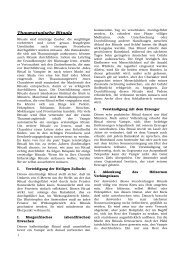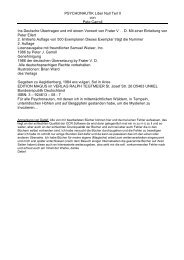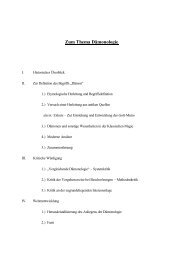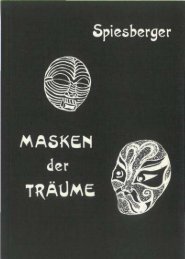CHAPTER 2 CHAPTER 3 CHAPTER 1 CHAPTER 2 CHAPTER 3 ...
CHAPTER 2 CHAPTER 3 CHAPTER 1 CHAPTER 2 CHAPTER 3 ...
CHAPTER 2 CHAPTER 3 CHAPTER 1 CHAPTER 2 CHAPTER 3 ...
You also want an ePaper? Increase the reach of your titles
YUMPU automatically turns print PDFs into web optimized ePapers that Google loves.
<strong>CHAPTER</strong> 2 17<br />
. nothing but light radiation . . . many millions of times brighter than your sun." No wonder space visitors are<br />
concerned over our atomic experiments!<br />
Before we leave the subject of atomic structure, let's glance at the idea of the inverted atom. Physicists have<br />
found short-lived particles in all cases that are the electrical opposites of the prevalent particles in our atomic<br />
structure. Some of these, including the newly found anti-proton have been found in cosmic rays. These are<br />
evidently the particles that form atoms built with negative nuclei and positive satellites. Substances<br />
constructed of such atoms would be identical except that they would be invisible to our physical senses, which<br />
were constructed to recognize substance formed of atoms having positive nuclei and negative satellites.<br />
Physical vision is sensitive only to positive light reflecting from negative substance on a negative planet. Inner<br />
perceptions see colors resulting from negative light. Neither reflections from negative substance or reflections<br />
from positive substance are reality, and neither are they visions . . . they are only reflections from reality.<br />
Now let us consider molecular structure:<br />
The structure of a molecule is dependent on the structure of the atoms of which it is composed. Science has<br />
recently found that in order for two atoms of hydrogen to associate themselves as a molecule, their respective<br />
single electrons must have opposite directions of rotation or spin. Thus we see the positive-negative<br />
association into oneness reflected even in the molecule.<br />
Like planets, some molecules possess rotational energy and others, such as the diatomic symmetrical<br />
molecules of hydrogen, nitrogen and oxygen, do not.<br />
When atoms or molecules are arranged in perfect order, the result is known as a crystal. Irregularity of atomic<br />
or molecular order results in a fluid. A true solid state is always in a definite crystalline form. Crystals of pure<br />
metals have recently been studied and it has been found that different crystal faces of a metal behave as if they<br />
were entirely different metals. Evidently, the crystalline geometrical forms determined by the<br />
electro-magnetic field of the atoms produce a differing field on each face.<br />
Crystals which do not have identical characteristics in all directions (not cubic) are called anisotropic crystals.<br />
When a ray of light enters an anisotropic crystal it is split into two components which travel with different<br />
velocities and follow different paths. Perhaps the crystal is here dividing the positive and negative light lines<br />
of force.<br />
Another interesting fact of molecular structure that has recently been revealed is that the thousands of atoms<br />
in fibrous protein molecules such as those composing hair, horn, fingernail, muscle and porcupine quill, are<br />
arranged in the form of a helix. This form results when asymmetric objects (the amino acids) are joined<br />
together in such a way that each one has the same geometrical relationship to its neighbors. Some of these<br />
molecules then form a compound helix or a coil of coils, etc. Thus science is discovering the linking forms<br />
between the atom and the biological structures.<br />
An electron micrograph of a bacterial flagellum has shown a three-strand cable which by its diameter suggests<br />
it is a seven-strand cable of seven-strand cables.<br />
The space people have said that the forms of crystals within the blood are the source of energy for man's every<br />
motion. The crystals in the blood, by diffusing, refracting and reflecting the positive and negative light lines<br />
of force, and by opposing polarized conditions, bring about the flow of the blood by light energy and as a<br />
result, the functioning of the heart.<br />
The fact that there are crystals within the blood stream is significant in relation to the use of the crystalline<br />
form in the Type 2 "fireball". For more information on them see The Harvesters in this book in the section<br />
called: Other Flesh.






